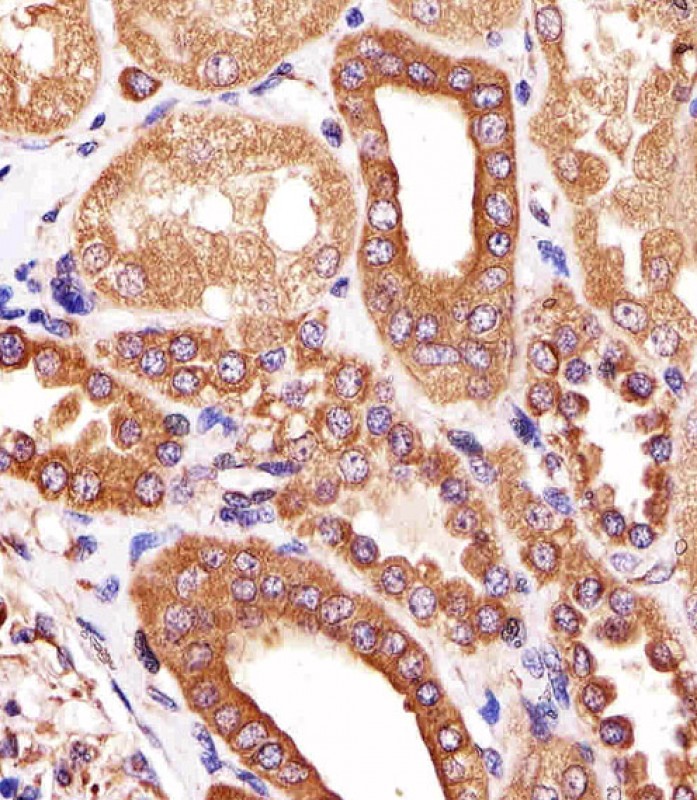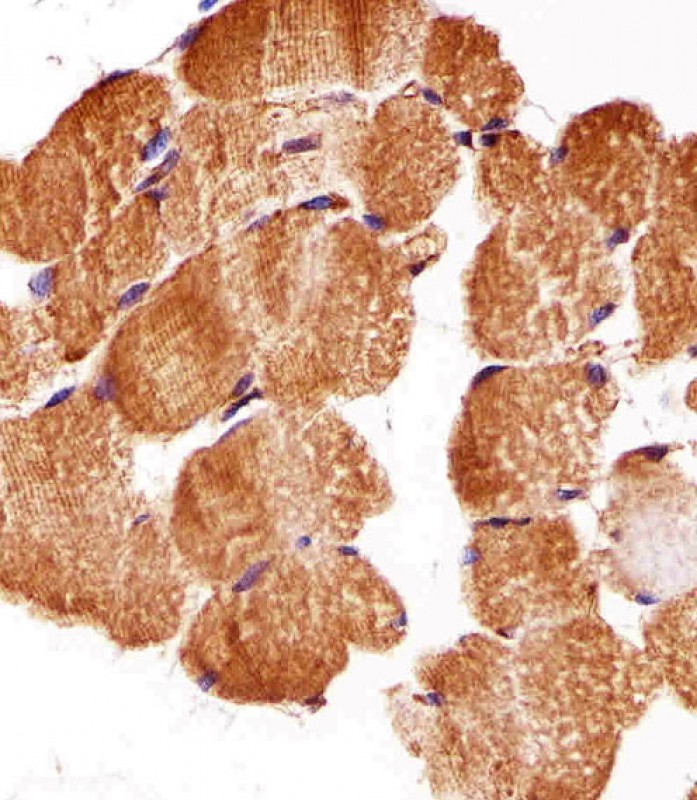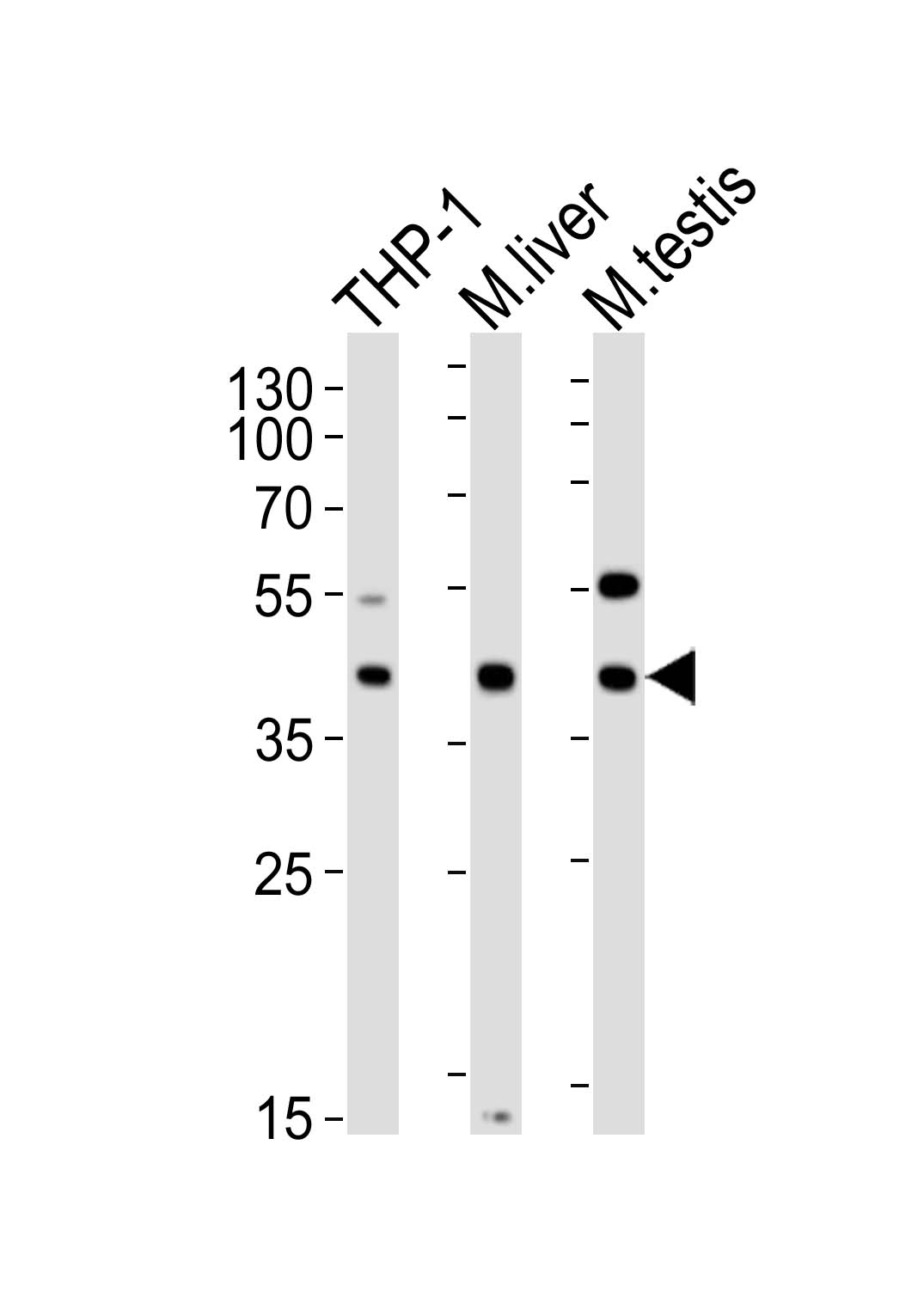ATG3 Antibody
Purified Mouse Monoclonal Antibody (Mab)
- 产品详情
- 实验流程
- 背景知识
Application
| WB, IHC-P, E |
|---|---|
| Primary Accession | Q9NT62 |
| Reactivity | Human, Rat, Mouse |
| Host | Mouse |
| Clonality | Monoclonal |
| Isotype | IgG1,k |
| Clone Names | 1377CT239.6.1.12 |
| Calculated MW | 35864 Da |
| Gene ID | 64422 |
|---|---|
| Other Names | Ubiquitin-like-conjugating enzyme ATG3, 632-, Autophagy-related protein 3, APG3-like, hApg3, Protein PC3-96, ATG3, APG3, APG3L |
| Target/Specificity | This ATG3 antibody is generated from a mouse immunized with recombinant protein of human ATG3. |
| Dilution | WB~~1:2000 IHC-P~~1:100~500 E~~Use at an assay dependent concentration. |
| Format | Purified monoclonal antibody supplied in PBS with 0.09% (W/V) sodium azide. This antibody is purified through a protein G column, followed by dialysis against PBS. |
| Storage | Maintain refrigerated at 2-8°C for up to 2 weeks. For long term storage store at -20°C in small aliquots to prevent freeze-thaw cycles. |
| Precautions | ATG3 Antibody is for research use only and not for use in diagnostic or therapeutic procedures. |
| Name | ATG3 (HGNC:20962) |
|---|---|
| Synonyms | APG3, APG3L |
| Function | E2 conjugating enzyme that catalyzes the covalent conjugation of the C-terminal Gly of ATG8-like proteins (GABARAP, GABARAPL1, GABARAPL2 or MAP1LC3A) to the amino group of phosphatidylethanolamine (PE)-containing lipids in the membrane resulting in membrane-bound ATG8-like proteins which is one of the key steps in the development of autophagic isolation membranes during autophagosome formation (PubMed:24191030, PubMed:33446636, PubMed:37252361). Cycles back and forth between binding to ATG7 for loading with the ATG8-like proteins and binding to E3 enzyme, composed of ATG12, ATG5 and ATG16L1 to promote ATG8-like proteins lipidation (PubMed:11825910, PubMed:12207896, PubMed:12890687, PubMed:16704426, PubMed:24186333). Also plays a role as a membrane curvature sensor that facilitates LC3/GABARAP lipidation by sensing local membrane stress associated with lipid-packing defects as occurs with high molar proportions of conical lipids or strident membrane curvature (By similarity). Interacts with negatively-charged membranes promoting membrane tethering and enhancing LC3/GABARAP lipidation (PubMed:29142222). Also acts as an autocatalytic E2-like enzyme by catalyzing the conjugation of ATG12 to itself in an ATG7-dependent manner, this complex thus formed, plays a role in mitochondrial homeostasis but not in autophagy (By similarity). ATG12- ATG3 conjugation promotes late endosome to lysosome trafficking and basal autophagosome maturation via its interaction with PDCD6IP (By similarity). ATG12-ATG3 conjugate is also formed upon viccina virus infection, leading to the disruption the cellular autophagy which is not necessary for vaccinia survival and proliferation (By similarity). Promotes primary ciliogenesis by removing OFD1 from centriolar satellites via the autophagic pathway (By similarity). |
| Cellular Location | Cytoplasm. |
| Tissue Location | Widely expressed, with a highest expression in heart, skeletal muscle, kidney, liver and placenta |
For Research Use Only. Not For Use In Diagnostic Procedures.
Provided below are standard protocols that you may find useful for product applications.
BACKGROUND
E2 conjugating enzyme required for the cytoplasm to vacuole transport (Cvt), autophagy, and mitochondrial homeostasis. Responsible for the E2-like covalent binding of phosphatidylethanolamine to the C-terminal Gly of ATG8-like proteins (GABARAP, GABARAPL1, GABARAPL2 or MAP1LC3A). The ATG12- ATG5 conjugate plays a role of an E3 and promotes the transfer of ATG8-like proteins from ATG3 to phosphatidylethanolamine (PE). This step is required for the membrane association of ATG8-like proteins. The formation of the ATG8-phosphatidylethanolamine conjugates is essential for autophagy and for the cytoplasm to vacuole transport (Cvt). Preferred substrate is MAP1LC3A. Also acts as an autocatalytic E2-like enzyme, catalyzing the conjugation of ATG12 to itself, ATG12 conjugation to ATG3 playing a role in mitochondrial homeostasis but not in autophagy. ATG7 (E1-like enzyme) facilitates this reaction by forming an E1-E2 complex with ATG3. Promotes primary ciliogenesis by removing OFD1 from centriolar satellites via the autophagic pathway.
REFERENCES
Tanida I.,et al.J. Biol. Chem. 277:13739-13744(2002).
Wu B.X.,et al.Submitted (NOV-1999) to the EMBL/GenBank/DDBJ databases.
Bechtel S.,et al.BMC Genomics 8:399-399(2007).
Ota T.,et al.Nat. Genet. 36:40-45(2004).
Tanida I.,et al.Biochem. Biophys. Res. Commun. 296:1164-1170(2002).
终于等到您。ABCEPTA(百远生物)抗体产品。
点击下方“我要评价 ”按钮提交您的反馈信息,您的反馈和评价是我们最宝贵的财富之一,
我们将在1-3个工作日内处理您的反馈信息。
如有疑问,联系:0512-88856768 tech-china@abcepta.com.























 癌症的基本特征包括细胞增殖、血管生成、迁移、凋亡逃避机制和细胞永生等。找到癌症发生过程中这些通路的关键标记物和对应的抗体用于检测至关重要。
癌症的基本特征包括细胞增殖、血管生成、迁移、凋亡逃避机制和细胞永生等。找到癌症发生过程中这些通路的关键标记物和对应的抗体用于检测至关重要。 为您推荐一个泛素化位点预测神器——泛素化分析工具,可以为您的蛋白的泛素化位点作出预测和评分。
为您推荐一个泛素化位点预测神器——泛素化分析工具,可以为您的蛋白的泛素化位点作出预测和评分。 细胞自噬受体图形绘图工具为你的蛋白的细胞受体结合位点作出预测和评分,识别结合到自噬通路中的蛋白是非常重要的,便于让我们理解自噬在正常生理、病理过程中的作用,如发育、细胞分化、神经退化性疾病、压力条件下、感染和癌症。
细胞自噬受体图形绘图工具为你的蛋白的细胞受体结合位点作出预测和评分,识别结合到自噬通路中的蛋白是非常重要的,便于让我们理解自噬在正常生理、病理过程中的作用,如发育、细胞分化、神经退化性疾病、压力条件下、感染和癌症。








